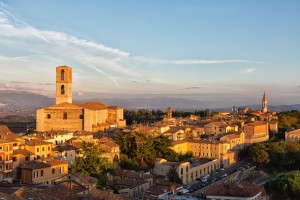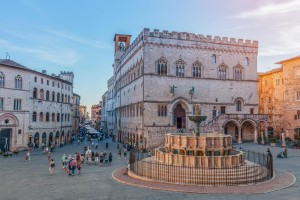The heart of Umbria harbours a very special city. Perugia, both capital of the region and of the eponymous province, can look back on a long history that goes back as far as the Early Iron Age. And this very history becomes palpable between the hilly historic centre and the newer, flat buildings. It is filled with ups and downs, like the landscape surrounding it, and leads to monumental churches and spectacular museums through narrow alleyways. Furthermore, the city of arts Perugia is home to massive festivals and events known far beyond Umbria. Find out what you absolutely have to see and experience in Perugia!
Perugia from the Iron Age to the Papal States
In order to find Perugia’s roots we need to travel back in time rather substantially; to the 9th and 8th century BC, to be precise, when the Villanova culture established their first settlements on the city grounds during the Early Iron Age. Contrary to legend, Perugia does not have Greek roots. It was likely founded by the Umbri before becoming Etruscan. Perusna, as it was known then, was one of the twelve confederate cities of Etruria. It became Roman in the Third Samnite War in 295 BC, gained civil liberties after the Social War of 91 to 88 BC, and was burnt to the ground after the Perusine War. Even though Augustus had the city, now called Augustus Perusia, rebuilt, it never managed to retain its former glory.
The end of the Western Roman Empire saw many rulers, including Ostrogoths, Lombards and Byzantine. Perugia eventually received its modern name during the Middle Ages. It finally managed to cut ties with the Roman emperor in 1198, was protected by Pope Innocence III and ruled by Guelf merchants. Perugia was the only Umbrian trade centre that, at the time, managed to gain a level of power and influence similar to that of the era’s large city states in Tuscany. All of this ended in 1540 when Pope Paul III put the Papal States into power after the so-called “Salt War” (the Perugini refused to accept a new salt tax). A massive fortress on Colle Landone reflected the new dominance, old districts on the foothill were buried, academia almost came to a standstill. Things stayed like that despite brief interludes and several uprisings until its incorporation into the newly founded Republic of Italy in 1860.
Perugia’s churches

©Bigstock.com/Lenor
Perugia’s highly eventful history left its mark on the cityscape. You will find most of the sights in the mountainous historic centre including a mass of churches. And they saw quite a few changes over the course of the centuries:
- Cathedral: Cattedrale di San Lorenzo is a latecomer. It was only completed in 1490 showcasing an unusually Gothic character during the Renaissance period. The raw external walls might have remained unfinished, yet the Cathedral gained a number of portals, annexes and even a campanile over the following centuries. The inside of the hall church, however, is caught somewhere between Late Renaissance and early baroque, highlights being Federico Barocci’s astonishing “Deposition from the Cross”, and the Holy Ring in a gilded tabernacle.
- Tempio di San Michele Arcangelo: Very few buildings survived the times as well as this early Christian church from the 5th or 6th Partially demolished and used as a military fortress, a number of restoration attempts in more recent times unearthed the old pillar structure and several frescoes.
- San Domenico: The Dominicans turned the bestowal of a small parish church into a colossal, three-nave hall church. However, it had to be fully rebuilt other than the Gothic exterior walls and the Renaissance cloister due to a structural collapse of the central nave in 1614. You will discover one of the largest Gothic windows ever in the slightly elevated choir.
- San Pietro: The first structures on this site might date back to the 10th century, but the current building was only established around 1600 as part of a Benedictine monastery. The longhouse structure carries early Christian features, the pillars evoke the memory of a pagan temple, while the choir with its Gothic and Late Renaissance endowment pulls off a stunning Venetian style.
- Oratory of San Bernardino: You’re probably wondering why we’re introducing you to a small chapel when there are so many churches to discover. Well, the Franciscan oratory outright wows with its incredibly ornamental, elaborate façade relief. The bright depictions on the temple-like marble façade simply need to be seen. Inside, the early Christian sarcophagus of the beatified Giles of Assisi, a companion of Saint Francis, serves as an altar.
Museums and secular buildings

©Bigstock.com/Artem Bolshakov
Sure, Perugia’s churches alone are genuinely spectacular, but the city of arts has so much more to offer. Time to take a look at a few more sights dedicated to the city’s fascinating history.
- Galleria Nazionale: Umbria’s national gallery is on the upper floors of Palazzo dei Priori. 40 rooms introduce you to noteworthy Umbrian painters and sculptors from the 13th to 19th
- Palazzo dei Priori: This very palace made predominantly of travertine, white and red stone has so much more to offer. The external staircase alone is a sight to behold. Various halls and colleges surprise with unusual shapes, wood panelling, painted walls and ceilings.
- National Museum of Umbrian Archaeology: The former convent near San Domenico now houses this astonishing archaeological collection. Eight sections invite you on a chronological journey through the region’s history from prehistoric exhibits that are up to 500,000 years old to exciting Roman pieces.
- Fontana Maggiore: The Perugini call it the most beautiful fountain in the world. Its spectacular reliefs certainly make Fontana Maggiore one of the most influential structures of its kind. The fields and tiles of this medieval masterpiece depict the life on earth divided into three themed cycles as well as personifications of important biblical and earthly figures.
- Arco Etrusco: One of the most important remnants of the ancient city walls is now flanked by imposing watchtowers. The Etruscan Arch was likely built in the 3rd century BC and incorporated into old Etruscan structures during the expansion of Via Amerina. Inscriptions on the archway point to Emperor Augustus and Emperor Gaius Vibius Trebonianus Gallus.
From jazz to chocolate
However, the city of arts Perugia isn’t “just” worth a visit as the site of breathtaking architecture. There’s also a lot happening throughout the year. We’ve picked two rather amazing event suggestions for you:
- Umbria Jazz: Perugia turns into the heart of the jazz world on ten days in July. Umbria Jazz is one of the most important European jazz festivals with legends of the genre and greats from different musical worlds visiting the city. Miles Davis, Alicia Keys, Carlos Santana, Dizzy Gillespie and Sting have all been part of Umbria Jazz.
- Eurochocolate: Umbria’s capital has been sweet like chocolate since 1993. Nearly one million Italians and tourists visit one of Europe’s largest chocolate festivals every year. There are a lot of delicacies to taste as well as concerts, exhibitions and activities. One of the highlights in previous years was a massive climbing wall that looked like a bar of chocolate.
The city of arts Perugia is very multifaceted, even spectacular with its astonishing features ranging from sweet treats to architectural highlights. You can feel the long, eventful history in the old alleyways going along very neatly with the newer districts and Umbria’s glorious nature. When will you visit magical Perugia?